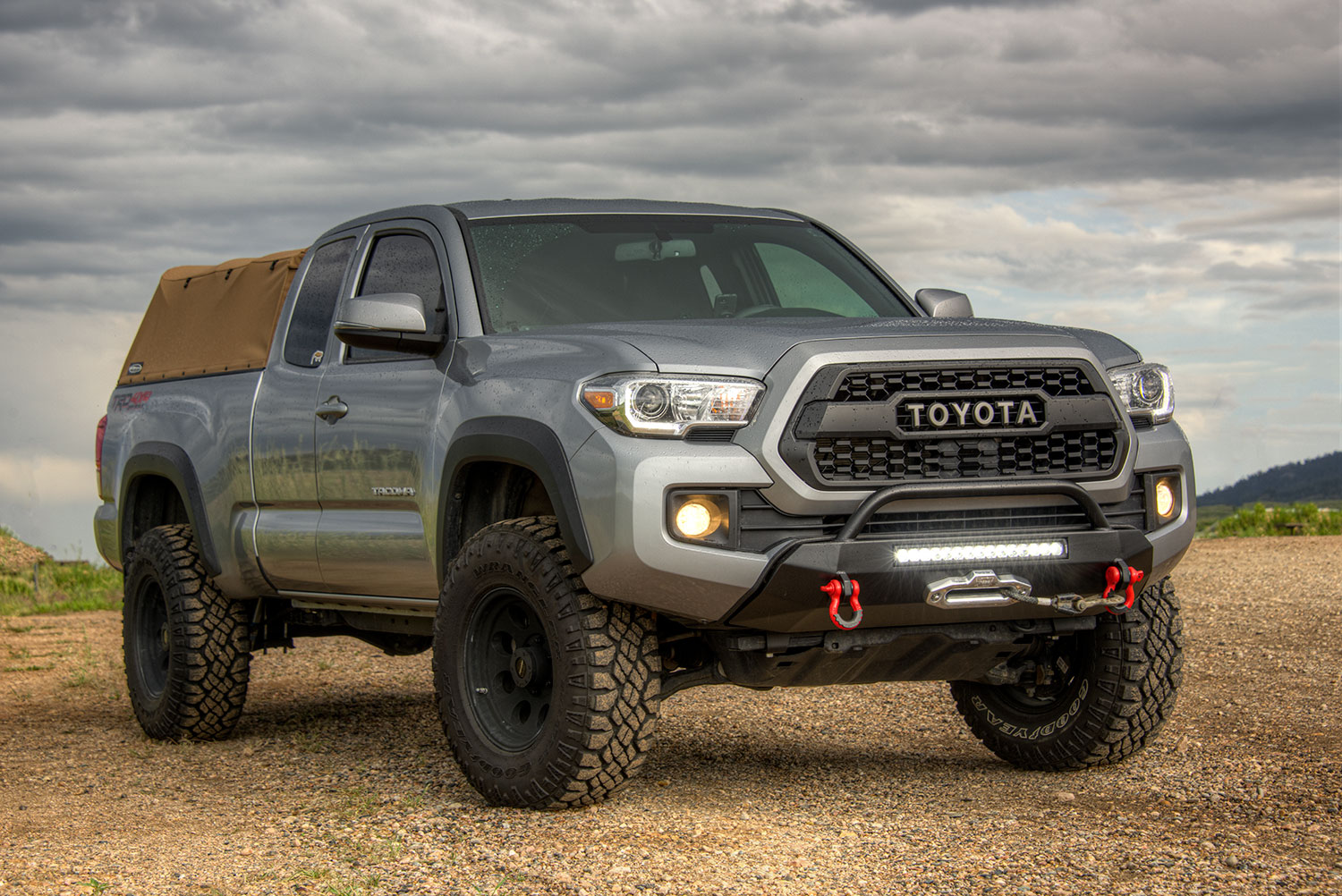
This is my second Tacoma overlander build, my first being a 2011. I wanted to keep this build practical with mods that I use on a regular basis or am likely to need. I didn’t want to succumb to the “big boy toy” mentality of building the “ultimate” truck with tons of extra gear that’s more bling than necessity. Additions with only a 1% chance of being needed still destroy fuel economy 100% of the time.
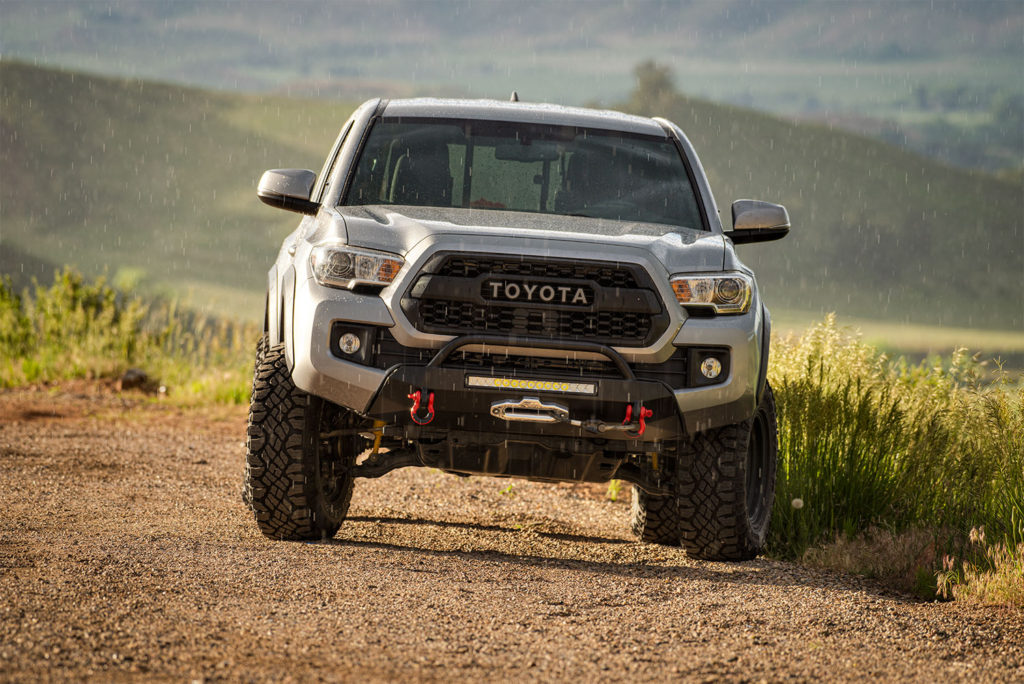
My trucks have always been overlanders for photography trips. Overlanding is about exploring the backcountry while living out of your truck, rather than aiming specifically to drive over obstacles. It typically covers long distances with a different camping spot each night. While avoiding obstacles if possible, an overland truck must still be built to tackle them when inevitable. On the other hand, an off-roading specific truck might have front and rear armor bumpers, rock sliders, skid plates, > 33″ tires, and a tall lift. An overlanding truck may have a modest lift with tires somewhat larger than stock, often front armor with a winch, but foregoing the additional body armor to save weight.
The most difficult sections of overland routes within my native Colorado are jeep trails over high mountain passes. They entail driving on perilously narrow shelves on an incline, composed of small boulders, with ledges that must be crawled over. This, followed by long stretches of highway and washboard forest roads.
*None of these products have been provided to me in exchange for review. The links below are affiliate links to Amazon.com.
Wheels
Cooper Discoverer AT3 LT LT265/75R16
You’ll notice in the pictures I’ve been running Goodyear Wrangler Duratracs. I’ve decided to replace them with Coopers. The Coopers receive better reviews for on and off-road performance, offer a 60,000 mi tread wear warranty vs Goodyear’s 50,000, are 2 lbs lighter per tire, and are about $60 cheaper for a set. They’re made in the USA and have a “C” load rating specifically in the 265 /75 R16 size.
Wheels: ProComp 7069, 16×8″ (6 on 5.5 Bolt Pattern)
As for the wheels, I don’t like shiny things on my trucks. I’m keen on a utilitarian military look with a proud stance, so I chose black ProComp 7069’s with -12mm offset.
Air Compressor: Superflow HD
An air compressor is required gear, IMO, for every vehicle because getting a flat from driving over debris is common. For overlanding you also need an air compressor to reinflate your tires after airing down for rough terrain. I’ve been using this effective Superflow for years now because it’s about the fastest, highest capacity standalone compressor on the market. It inflates 33’s from 15psi up to 45psi in about 4 minutes each. It derives extra juice by clamping directly to the battery instead of the lighter plugin. I’ve had lesser air compressors before, which suck the day away because they inflate so slowly.
Brass Tire Deflators: Boulder Tools Deflator Set
Tire deflators screw onto your valves and deflate your tires to a preset PSI without you having to sit there. You can actually screw them on and drive off as they work.
SUSPENSION LIFT
 Front: Old Man Emu Nitrocharger Shock (90021) with 2888 Coilovers
Front: Old Man Emu Nitrocharger Shock (90021) with 2888 Coilovers
I wanted a modest 2″ lift that was more capable than stock suspension. Based on value and reviews, I originally chose the Bilstein 6112 lift kit, but it was back-ordered for at least 8 months at the time of my build. Instead I opted for an Old Man Emu setup consisting of 2888 coilovers with 90021 Nitrocharger shocks. With only a 2″ lift I could have gotten away with no upper control arms. But despite their high cost, I wanted to do it right the first time to avoid worry about imperfect alignment and uneven tire wear.
Upper Control Arm: SPC 25470
Rear: Icon Progressive Add-a-leaf
The complete OME lift kit that’s listed above is great, but I ended up piece-mealing my rear suspension to suit my extremely light rear end with just a Softopper. A block lift, though scorned, would probably have been fine, but not a good choice if I ever added future weight. As for a standard add-a-leaf, I was concerned that it could have given my light rear-end too much lift and a bone rattling ride. Based on feedback in discussion boards I chose an Icon progressive Add-a-leaf, and removed my overload spring. I paired it with Bilstein 5100 shocks.
The new suspension feels significantly better. The stock suspension rode mushy like a boat, with severe body lean on curves. My OME/Bilstein combo is pleasantly firmer than stock and eliminated the lean, yet is still plush on pavement.
FRONT BUMPER/WINCH
 Bumper: SSO Slimline Bumper with 20″ HEISE LED
Bumper: SSO Slimline Bumper with 20″ HEISE LED
After driving around with an ARB bull-bar front bumper on my last Tacoma and never needing it, I realized that it looked awesome, but decreased efficiency in every way. Yet I still wanted a front recovery point and spot to mount a winch. I chose the Slimline Hybrid Bumper by Southern Style Offroad. It’s a good compromise to avoid weight while maintaining function and looks. I like the integral 20″ LED light bar too. As for the winch, I run a Warn 10,000 lb.
Alternative Bumper: Body Armor HiLine
This front bumper is the same style as the above-mentioned Slimline, but it’s much less expensive, and there’s usually no lead time when ordered through Amazon (otherwise, lead times can average 2 months for other bumpers).
Winch: Warn VR 10-S
Front Grill: Tacoma TRD Pro Aftermarket Grill
I liked the looks of the 2nd gen Tacoma front end, but not so much the 3rd gen with it’s blunt nose and busy honeycomb grill. I replaced the stock grill with a knock-off TRD Pro grill that made a big improvement.
What about a Rear Bumper and Fuel Cans?
I had a rear bumper with a carrier swing arm on my last Tacoma and hated it. The extra weight and constant hassle of getting into my topper wasn’t worth just having someplace to mount a rarely needed Jerry can. Now, in the rare event that I go on a truly off-grid trip, I mount a NATO spec 5 gallon Jerry can inside my bed and store it outside overnight. In Colorado it’s unlikely that I’ll exceed my Tacoma’s range before passing a fuel station. Most fuel containers leak; a genuine NATO spec can with a real (non EPA) spout is the only type I’ve found that won’t.
RECOVERY GEAR
Heavy Duty Bottle Jack: Alltrade 3 Ton
The factory bottle jack is too short to jack a truck with a lift kit without propping it up with wood blocks, and it’s too unstable on uneven terrain. Instead I used to carry Hi-lift jack , but it’s the size of an Ostrich and just as awkward to store. While very useful for rock-crawling (and on the farm), it was overkill for me and I wanted something smaller. Besides, a Hi-lift can only jack where there’s body armor, and I only have a front bumper on this truck. I decided to try out the Alltrade jack because it has a built-in jack stand, and an extra tall neck. So far it has worked fine with no leaks, and it stores easily.
Tree Saver Recovery Strap-ARB Strap
D-Ring Shackles-Autmatch
Snatch Block-Warn 20,000 lb
Work Gloves: Ironclad Ranchworx
Complete Recovery Kit-Warn Medium Duty Winch Kit
You need a minimum of 3 items to winch: a recovery strap (tree saver), pair of D-ring shackles, and snatch block (pulley). The strap wraps around the tree –> the D-ring attaches the snatch block to the strap –> the winch rope runs through the snatch block and back to your truck –> the winch hook attaches to the second D-ring on your truck. For single line winching you don’t need a second D-ring or snatch block, but you’d always opt for double line if possible because it’s safer and doubles the winch’s power.
Recovery Tracks-X-Bull Recovery Tracks
Recovery tracks are cheap insurance to recover yourself when stuck, especially if you don’t have a winch. And beyond the obvious purpose of slipping these tracks beneath spinning wheels, they can also serve as a ramp to ease up ledges that you don’t otherwise have enough nose clearance for. I end up using them most often to level my truck to sleep flat than for recovery. The X-Bull recovery tracks are a much cheaper alternative to the venerable MaxTrax, but rate practically as well in tests.
- For recovering your truck when stuck
- For leveling truck to sleep flat
ELECTRICAL POWER
 Battery Jump Starter: DB Power 18000
Battery Jump Starter: DB Power 18000
Figuring out auxiliary power was the most confusing part of this build. At first, a dual battery system seemed the obvious choice. However, trying to decipher between the different systems, and how complex it really needed to be was baffling. My local 4×4 shops had very little knowledge on the topic, yet still charged heftily to install them. I was keen on wiring it myself, but was clearly out of my depth. Furthermore, adding the weight of a second battery to my front end along with the complexity of running wires, switches and fuses made it seem evermore unpractical. Ultimately, my power needs were basic, and I realized that there might be more practical solutions than a dual battery system. I simply wanted to run accessory lights at night, and have backup in case my battery goes flat.
Then I discovered some inexpensive gear that didn’t exist during my last build, and could serve in place of a DBS. Because of bad experiences with unreliable jump boxes, I kept an actual battery in the bed of my truck in case I needed to jump myself. But recently, tiny, powerful jump starters based on Li-ion batteries have entered the market. The DB Power jump starter that I purchased cost under $100, holds enough juice for several jumps, and can be left in the glove box for months without recharging. It can even charge e-devices, though I keep mine reserved for just jump starting.
Over the past year I’ve eagerly been on the lookout for fellow motorists who required a jump to test this mini jump starter. I’m happy to report that I’ve successfully jumped vehicles ranging from a motorcycle to an F-250 Diesel, with each jump sipping only a scant 10% of battery power on average. About 10% of the jump starter’s battery life dissipates every 3 months when kept in the glove box.
Tailgate Lantern: Suboos Camping Light
Overhead Reading Lights: Ansuo LED Lights
The only electrical accessories that I wanted were a lantern above my tailgate to cook meals at night, and 2 small lights inside my topper to read. For the lantern I found an inexpensive, versatile tent lantern that included high, medium and red modes. For the reading lights I found simple LED cabinet lights that I attached to the bars of my Softopper. Each light runs on rechargeable batteries that can be charged while I drive, so it’s still technically a self-contained system. After trying several brands of rechargeable batteries, I’ve come to rely on the the Panasonic Eneloop Pro’s for their lifespan and power output.
Though not as impressive as a dual battery system, the combo of a jump starter and battery powered lights is infinitely simpler, and only cost me $130. A DBS with additional wiring and switches would have cost me well over $1000, plus the weight and potential failure points. A DBS is definitely more useful for people with fridges who spend a lot of time camped with their truck. However, when my current battery needs replacement I’d consider upgrading to a large capacity/deep cycle battery that accessories can be hard-wired to without concern. Combined with my jump starter, this would be like having a dual battery system.
Bed Outlet Charging Station
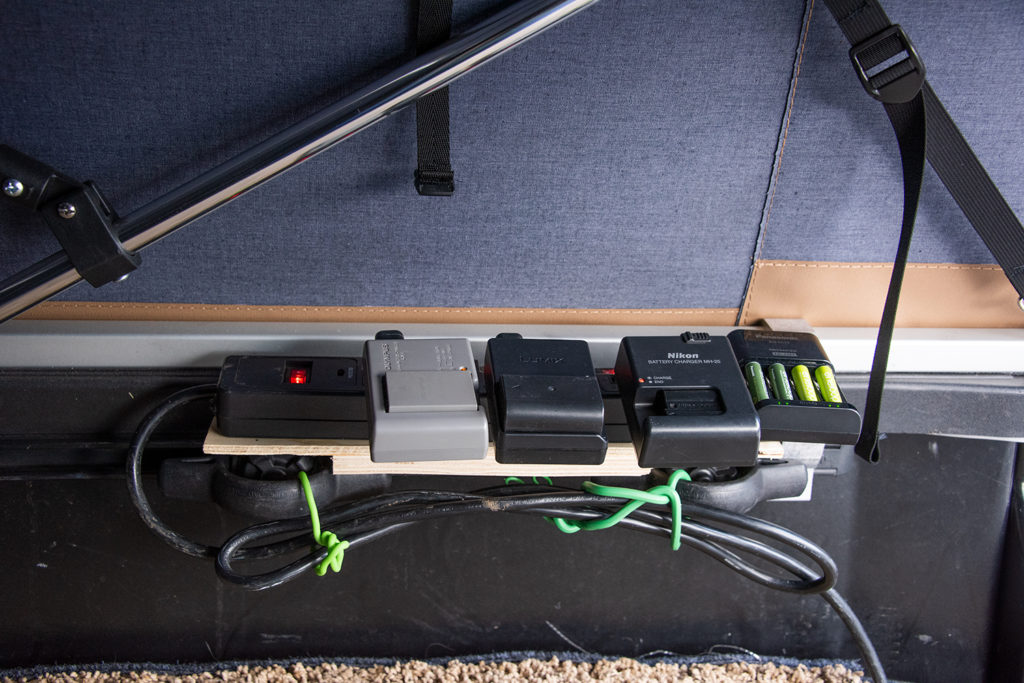 The Tacoma comes with a standard wall outlet built into the bed that provides 400 w when the engine is running, and 100 w when off. This is the perfect place to plug in a power strip and recharge my camera batteries while driving. Otherwise, they’d very much be in the way in the cab if plugged into the 12v outlet. I built a small platform to mount the power strip to make a handy charging station.
The Tacoma comes with a standard wall outlet built into the bed that provides 400 w when the engine is running, and 100 w when off. This is the perfect place to plug in a power strip and recharge my camera batteries while driving. Otherwise, they’d very much be in the way in the cab if plugged into the 12v outlet. I built a small platform to mount the power strip to make a handy charging station.
TOPPER
 Softopper Canvas
Softopper Canvas
Deciding to go with a Softopper diverged greatly from my original plan for this build. After having regular fiberglass toppers on all my trucks to camp in, I finally wanted a popup tent topper so I could stand up to change my clothes and have a spacious niche to wait out bad weather. However, they cost between $6,000-$12,000 (often with very long wait times), yet they’re nothing more than a regular topper with a pop-up tent on top. In the end I couldn’t justify the high price for something that I didn’t use daily, and also didn’t want to line somebody’s pocket for such a simple product.
I went radically in the other direction of a Softopper. It was a no-brainer for me because you get the same amount of interior space as a cab-height fiberglass shell, yet the Softopper weights only 35lbs, and you can fold it down to use the bed. Since I’m usually only in the bed of my truck for a few hours of sleep anyway, I decided that reduced comfort was worth preserving the performance of my truck.
Dust Proofing
Expanding Insulation Foam: Great Stuff Foam
Bed Cap Tape: 50 Ft Adhesive Foam
 Tailgate Seal: TruXedo
Tailgate Seal: TruXedo
All toppers are inherently dusty without additional sealing, and the Softopper has a few more slits than usual. Rather than waiting to see if this is a problem on the dusty roads of the American west, I preemptively sealed up the gaps. I squirted expanding insulation foam down into the hard to reach crannies, used foam seal tape along the bed rails, and sealed the large tailgate gaps with a strip of tailgate seal. After a multi-thousand mile trip through the Southwest, the inside of my topper stayed clean and dust free.
 Cargo Net: Toolux Adjustable
Cargo Net: Toolux Adjustable
Overland travel entails the art of maximizing small spaces. I suspended a cargo net from the roof of my topper to stow light items like clothing to save deck space.
Sleeping Deck
I built this sleeping/cargo deck for my 2nd gen Tacoma, and it still fits the bed of my 2017 Tacoma perfectly. However, to fit the lower height of the Softopper I’ve chopped 5″ off the supports. It rests on the wheel wells and a center column, and has 9.25″ of cargo space underneath. You can place only 1 section into the truck for a single sleeper while keeping half of the truck bed open, or 2 sections to form a large flush floor for 2 sleepers. The whole deck lifts out of the truck in seconds for full use of the bed. I found only 1 specific tote on the market that’s voluminous enough to store all of my dry food and gear, yet still fits beneath the deck. I can fit up to 6 of these totes in the bed.
Mattress: Full-size Memory Foam
When I’m alone I just use my camping pad as a mattress, but when the GF tags along I use a 2″ thick memory foam mattress. The full size fits perfectly on the sleeping deck in the bed of my Tacoma.
Emergency Box: Plano XXL Tote
I permanently carried this sturdy, large capacity chest in the bed of my last Tacoma for emergencies. Because I lowered the height of my sleeping deck, this box no longer fits beneath it and I’ve built my own chest to fit, but it’s still an awesome choice for any truck with an open bed or taller deck. I keep the following items in the chest for emergency, some of which I’ve used:
- Jug O’ Zip Ties– I use these frequently for unexpected things that need to be held in place
- Ratchet Straps– For securing large cargo in the bed
- Duct Tape– Need I explain?
- Flat Repair Kit
- Extra Coolant
- Extra Oil
- Extra Serpentine Belt
- Auto Tool Kit
- WD40– Many uses including getting seized parts unstuck
- Radiator Sealer
- Hose Clamps– For very tightly holding things together that have come apart
- Bow Saw
- Aquarium Air Hose– For siphoning fuel if needed
- Rubber Gear Ties
- Heavy Shirt
- Coat
- Snow Pants
- Hat
- Knit Cap
- Gloves
- Old Hiking Boots
- Shovel
- Hatchet
- Candles- For romantic dinners in the bush
- Lighters- Because if your truck won’t start in Winter you may need a fire
- First Aid Kit
Fire Extinguisher-Car Mounted Extinguisher
This is cheap insurance to stop potential disaster. Though I’ve never had a close call with fire, I do think the chances of encountering fire are greater in an off-road/overlanding environment considering all of the extra electronics and cooking gear carried. A fire extinguisher would also be good should your camp fire misbehave.
CONVENIENCE
Remote Start: Start-X
When doing photography in the Rocky Mountains I often start the day when it’s still dark and icy. With remote start I can emerge from my sleeping bag and hop right into a warm cab with the ice already melted off the windshield. The Toyota dealership quoted me over $500 dollars to install remote start, but I installed this easy setup kit myself in about 25 minutes saving me over $300!
Console Organizer: 6-slot Divider
This organizer adds partitions inside the console so that items won’t be piled on top of each other, thereby doubling usable space.
Phone mount: Scosche Magnetic Mount
It might seem funny to include such a seemingly trivial product, but this phone mount has made my life way easier while driving. I mounted it horizontally to reduce the likelihood of falling off. It attaches perfectly on the flat space above the vent by my right hand where I need my phone most. Without the phone mounted, it’s nothing more than a small nub that occupies little space.
Wire Gear Ties: Tipu 16 Pack
This pack of gear ties is a good bargain with 16 ties of various sizes. They can be found all throughout the cab and bed of my truck keeping equipment from rattling and securing gear in place.
 Access Cab Cargo Deck
Access Cab Cargo Deck
I built this deck to fit behind the front seats in my access cab to double the cargo capacity, effectively giving you the storage space of a quad cab. There are no front legs underneath as to allow long items to fit all the way across. In lieu of front legs, 2 straps suspend it from the front head rests, and it rests on the center console. I covered it with thin carpet to prevent objects from sliding around.
LED Backup Bulbs: Alla SuperBrights
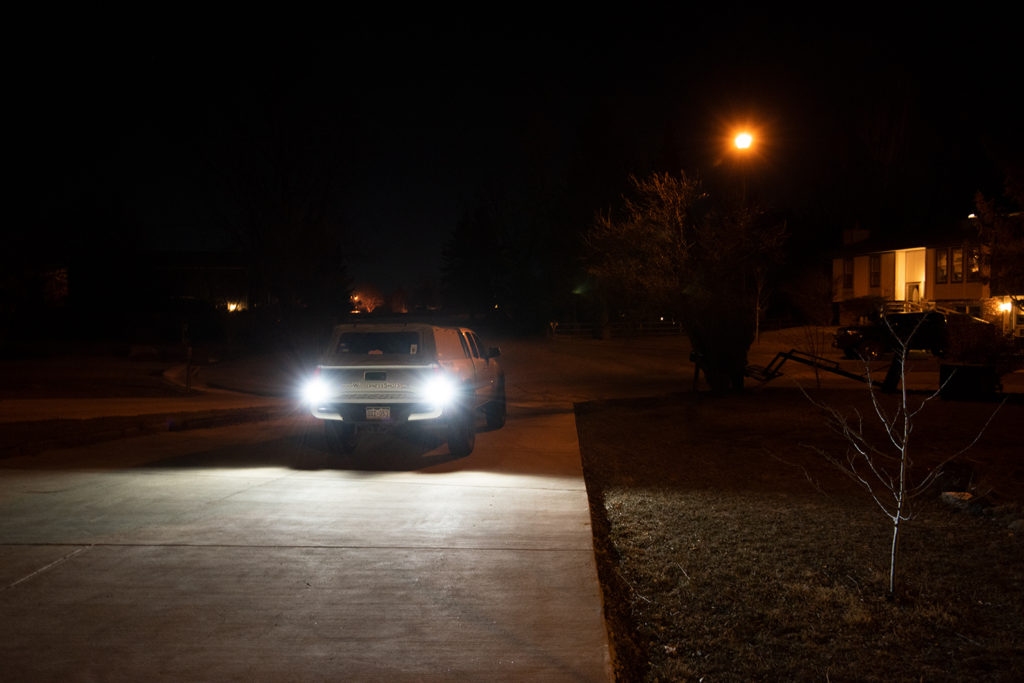 Pound for pound these LED backup lights were among the best upgrades because they’re cheap and easy to install, yet make a big improvement. They’re also a good compromise to installing expensive stand-alone LED lights. Where the stock bulbs were just bright enough to get the job done, these LED’s are several times brighter.
Pound for pound these LED backup lights were among the best upgrades because they’re cheap and easy to install, yet make a big improvement. They’re also a good compromise to installing expensive stand-alone LED lights. Where the stock bulbs were just bright enough to get the job done, these LED’s are several times brighter.
FOOD/WATER STORAGE
Keeping your gear organized, separated and in specific places goes a long way in making overlanding a frustration free adventure. I use these items because they’re both tough, and fit beneath my decks system.


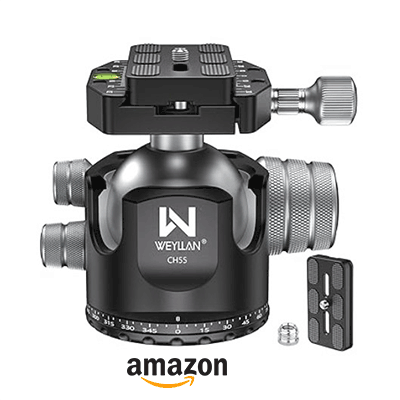
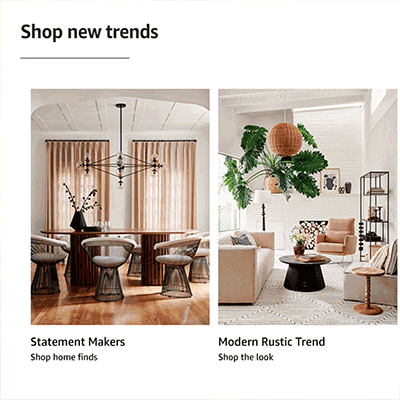

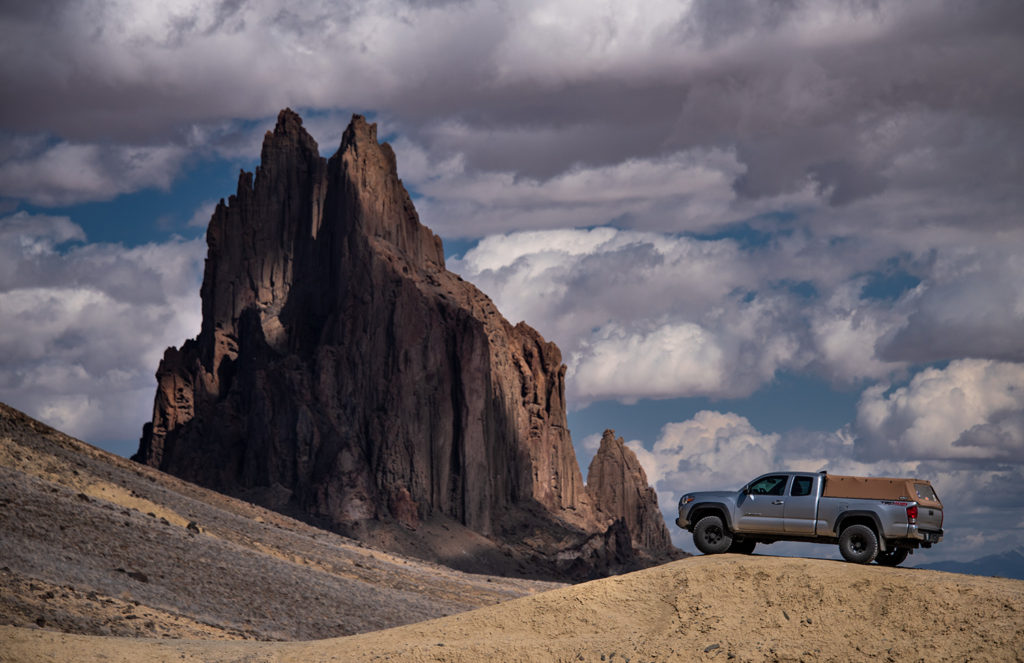
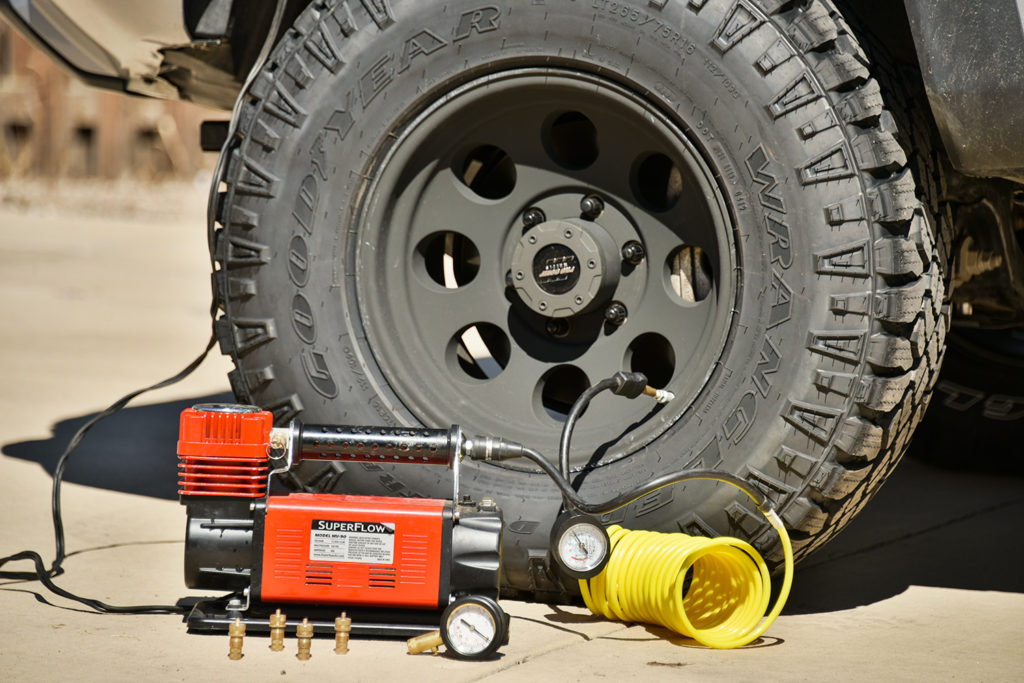
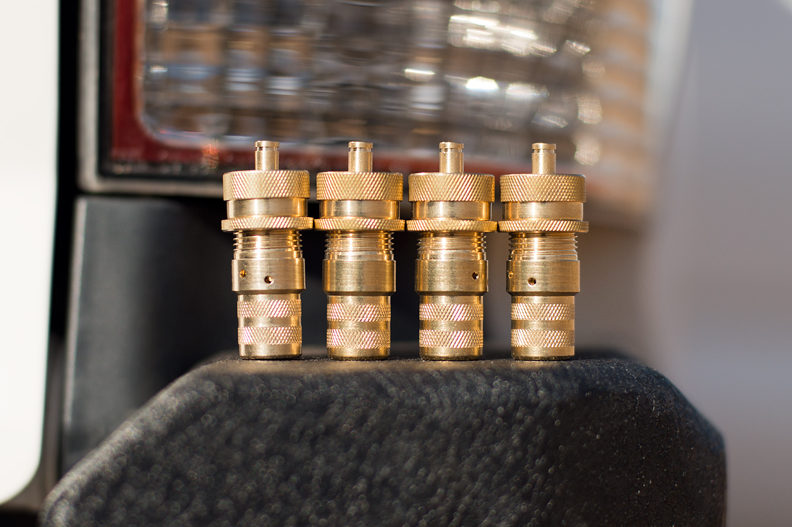
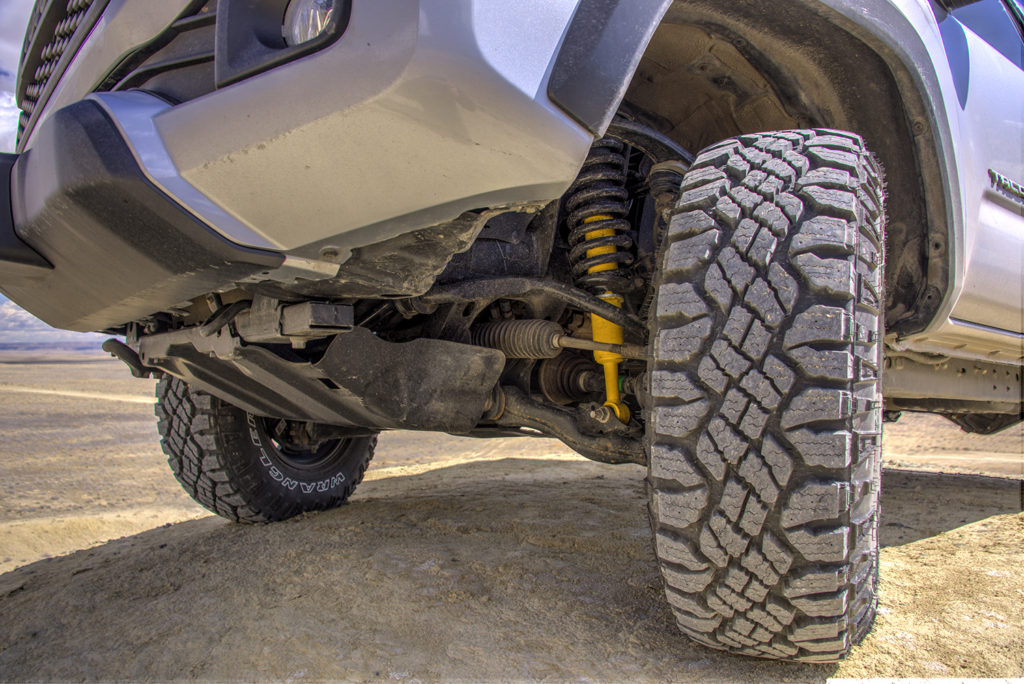
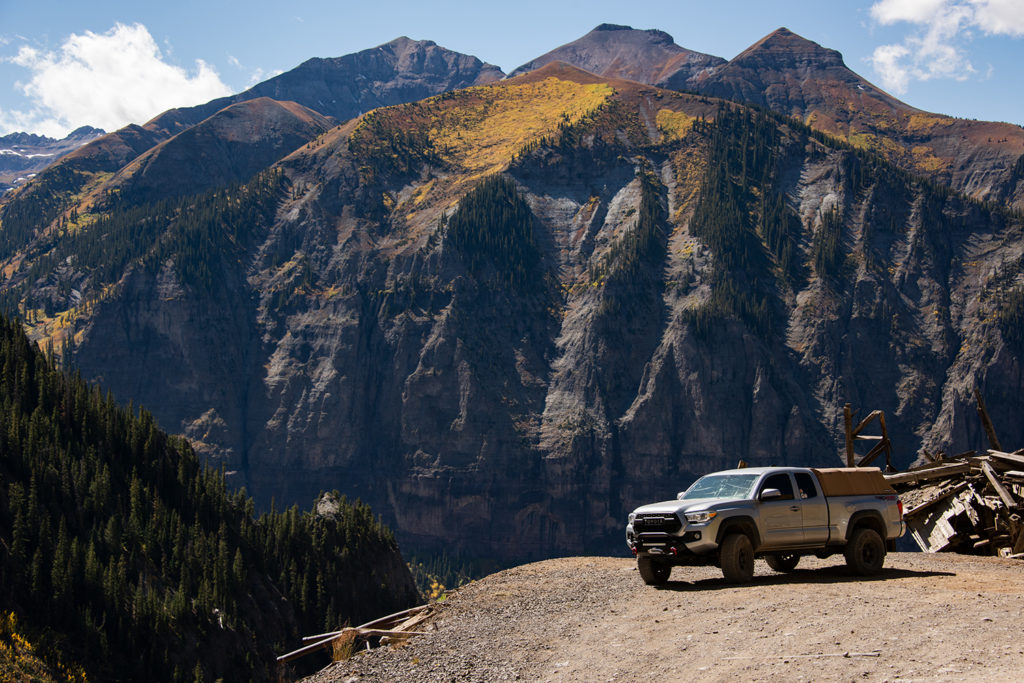
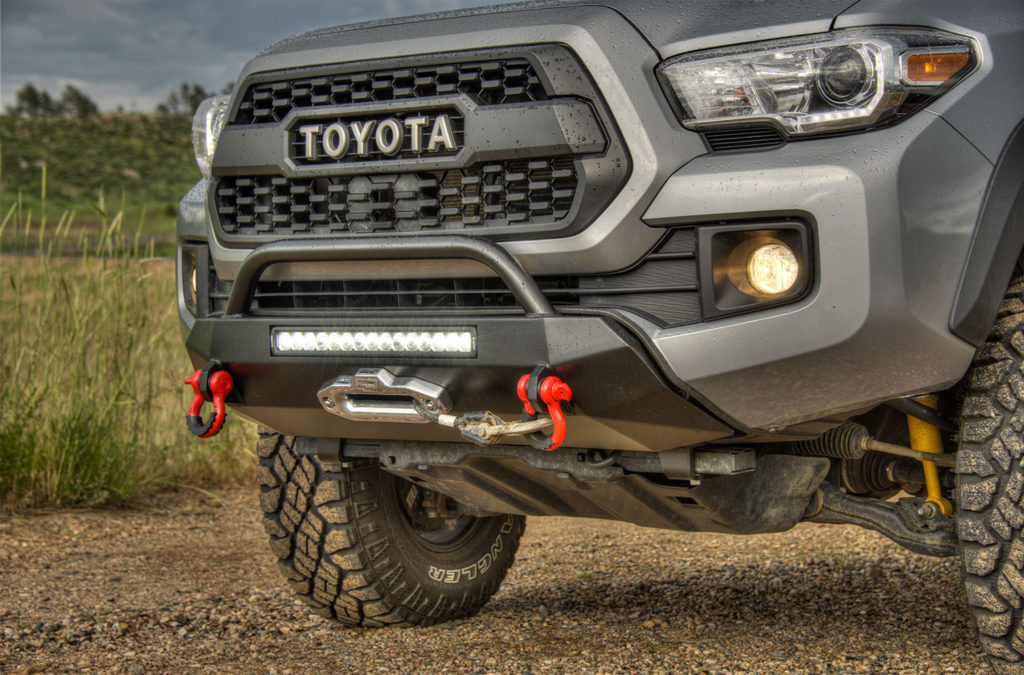
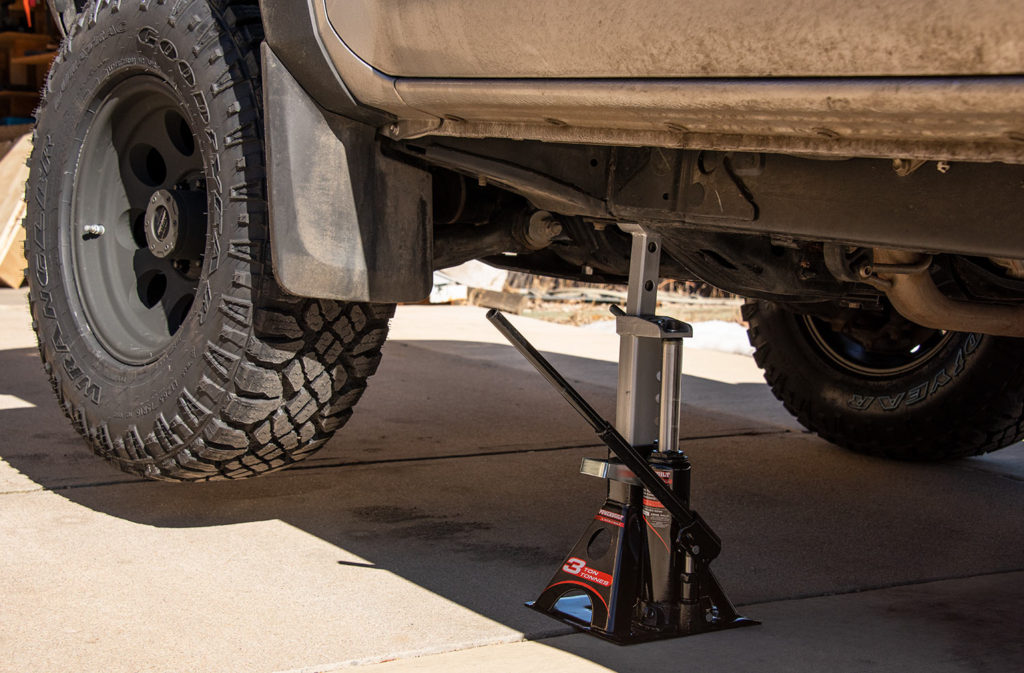
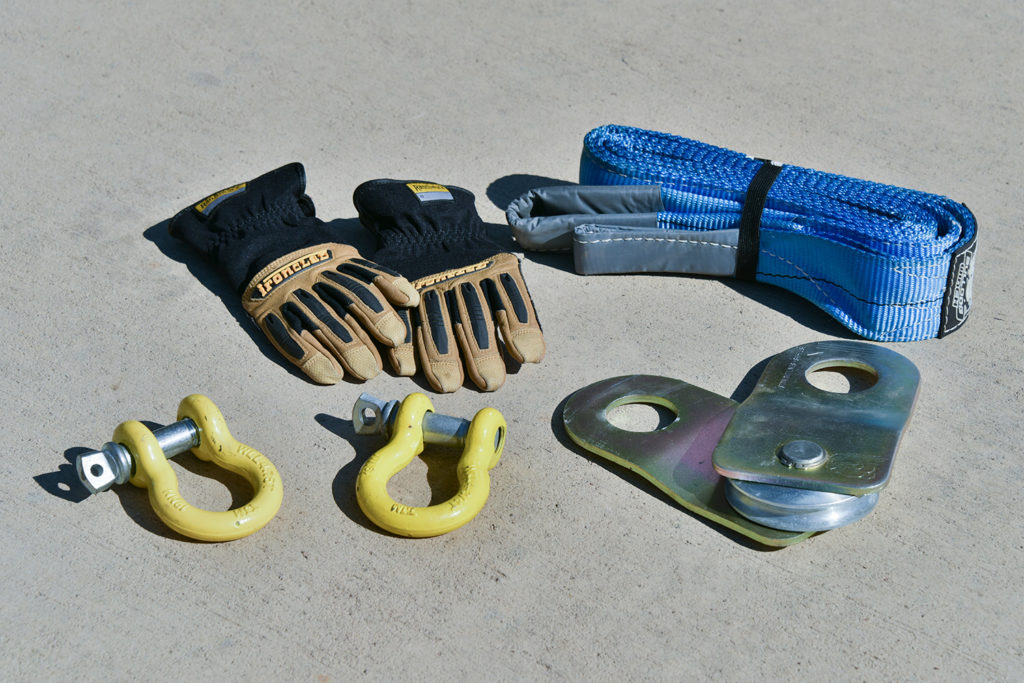
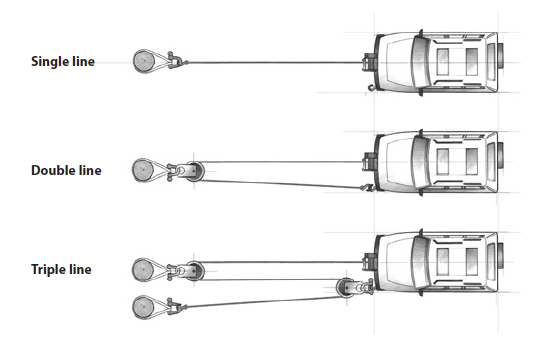
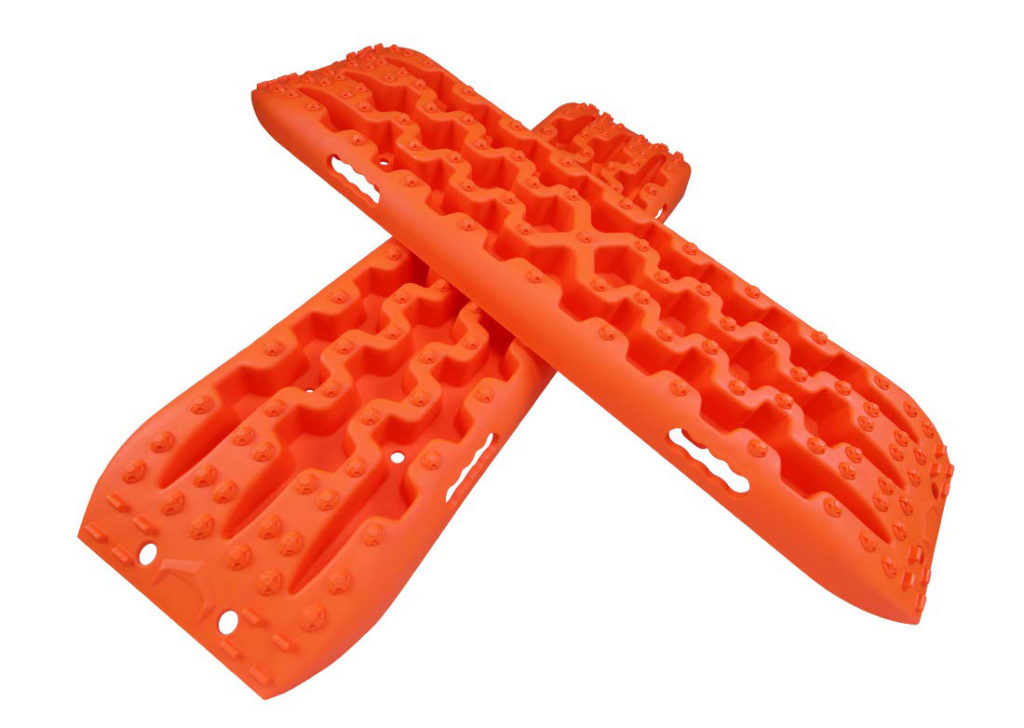
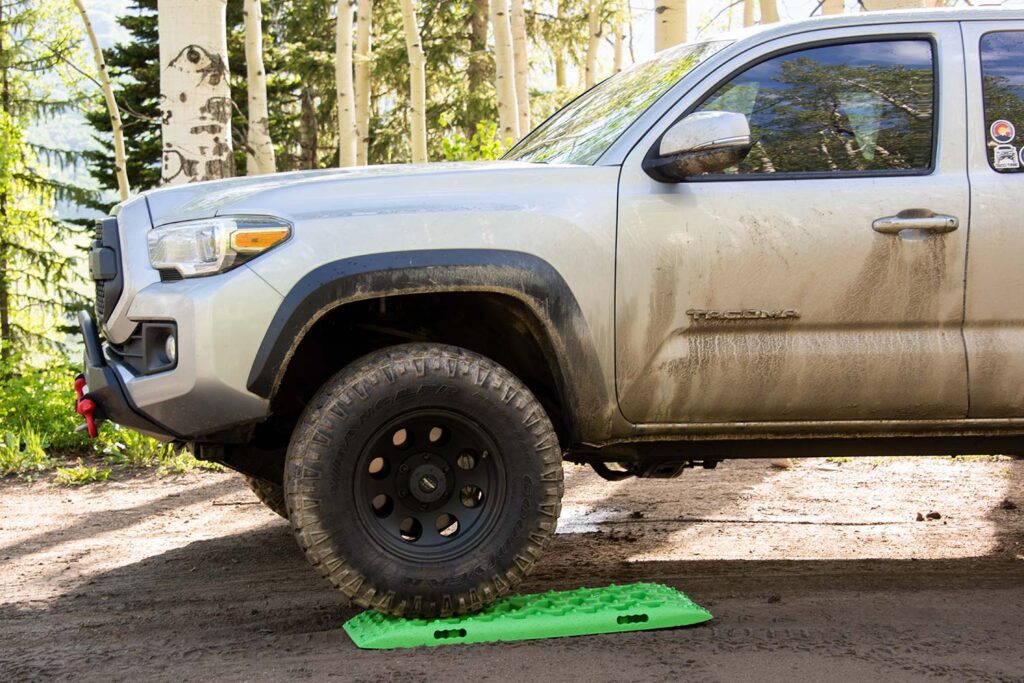
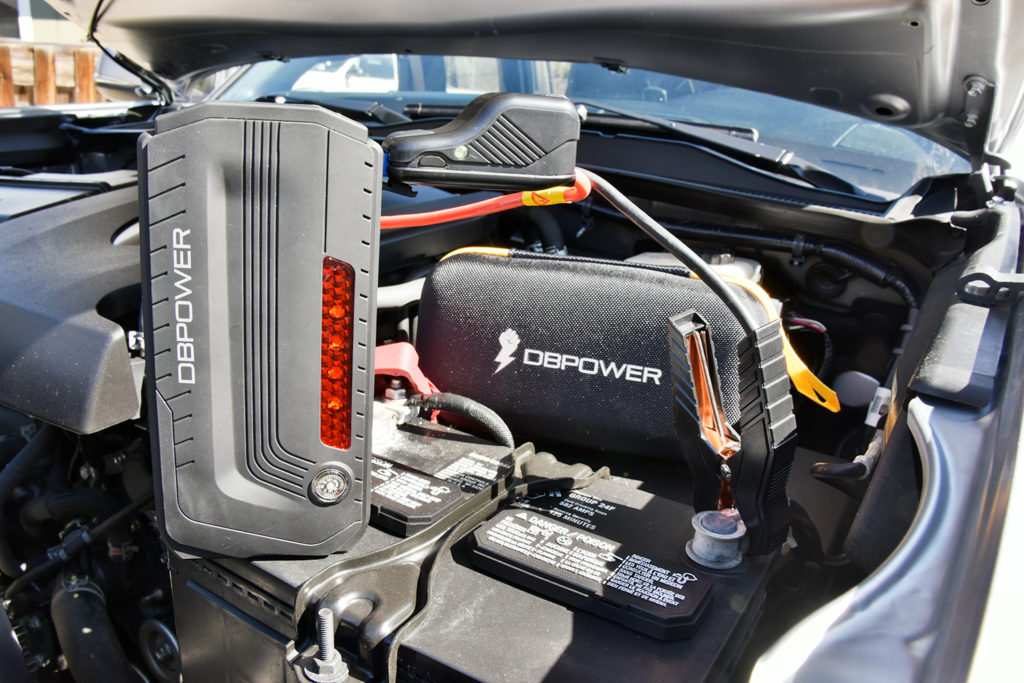
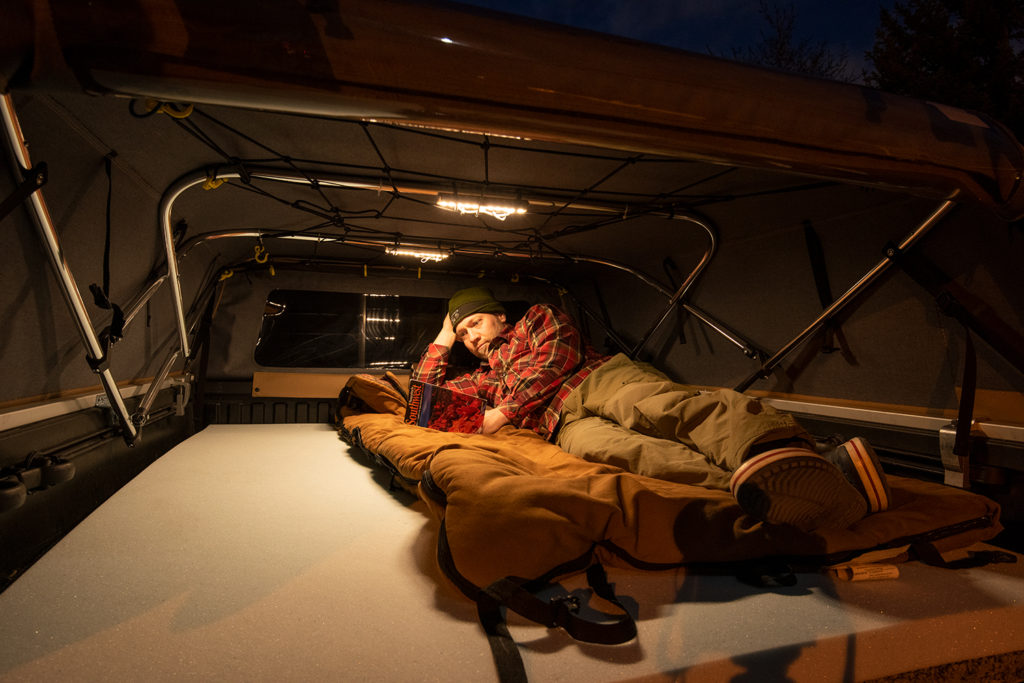
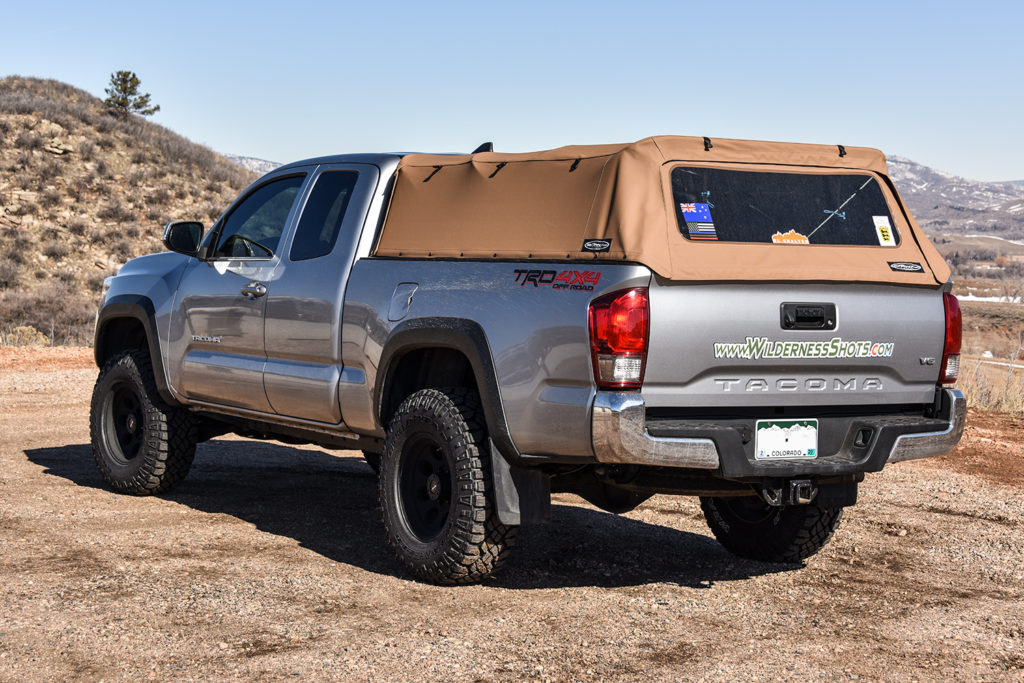
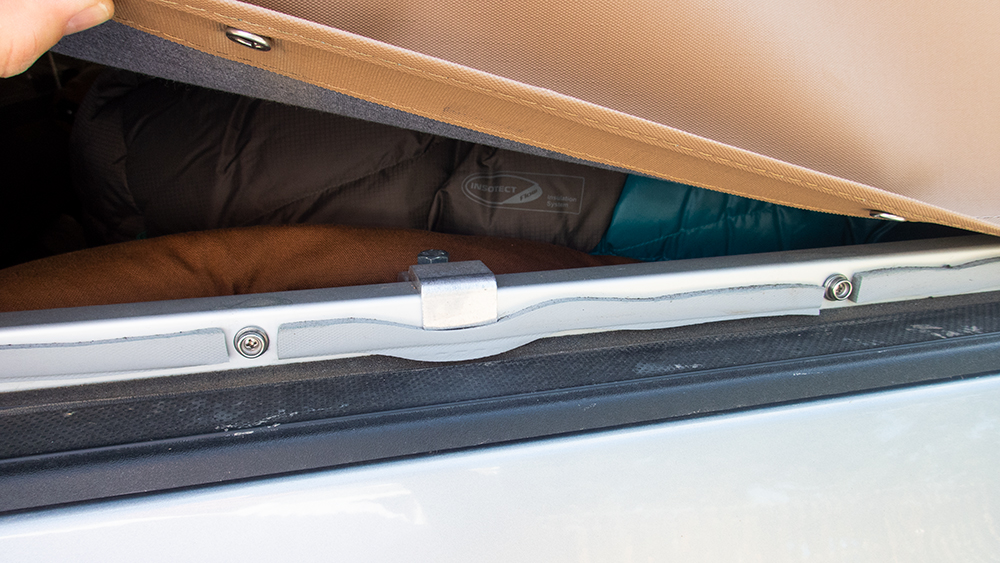
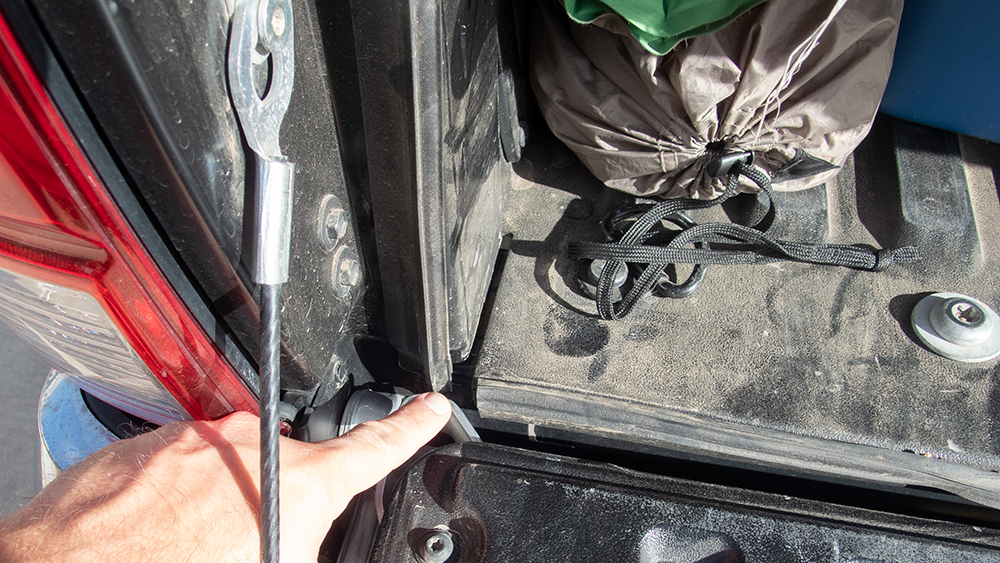
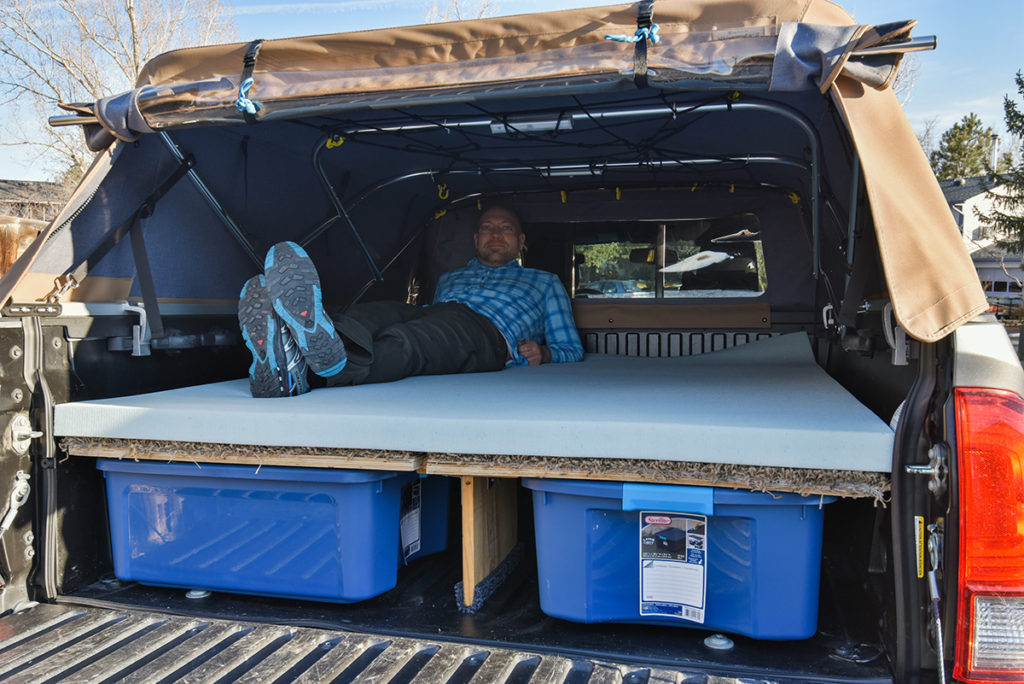
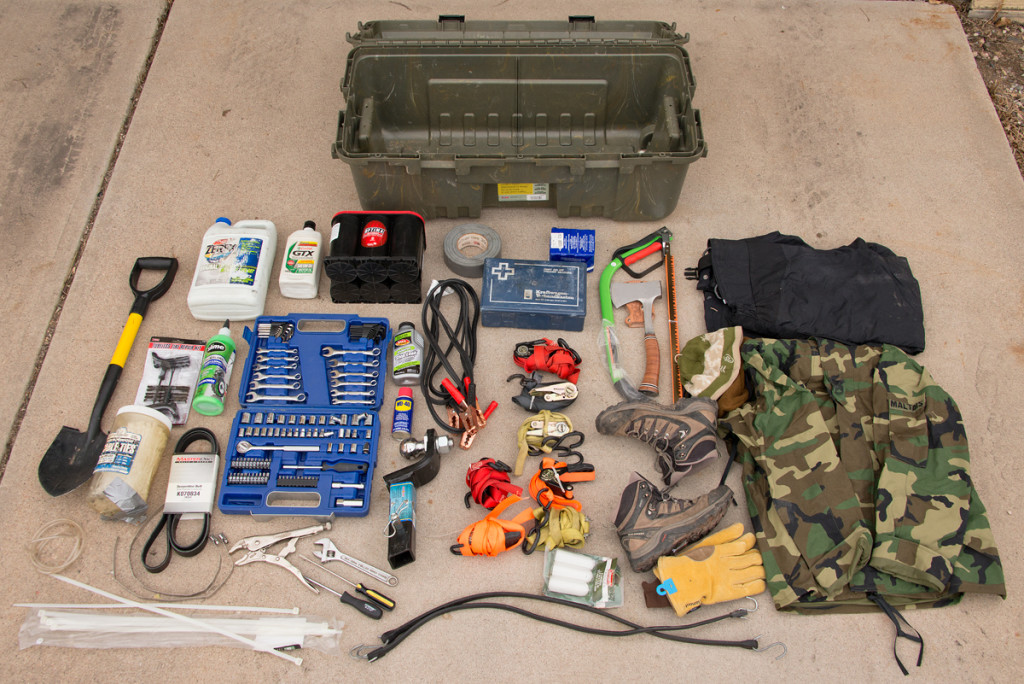
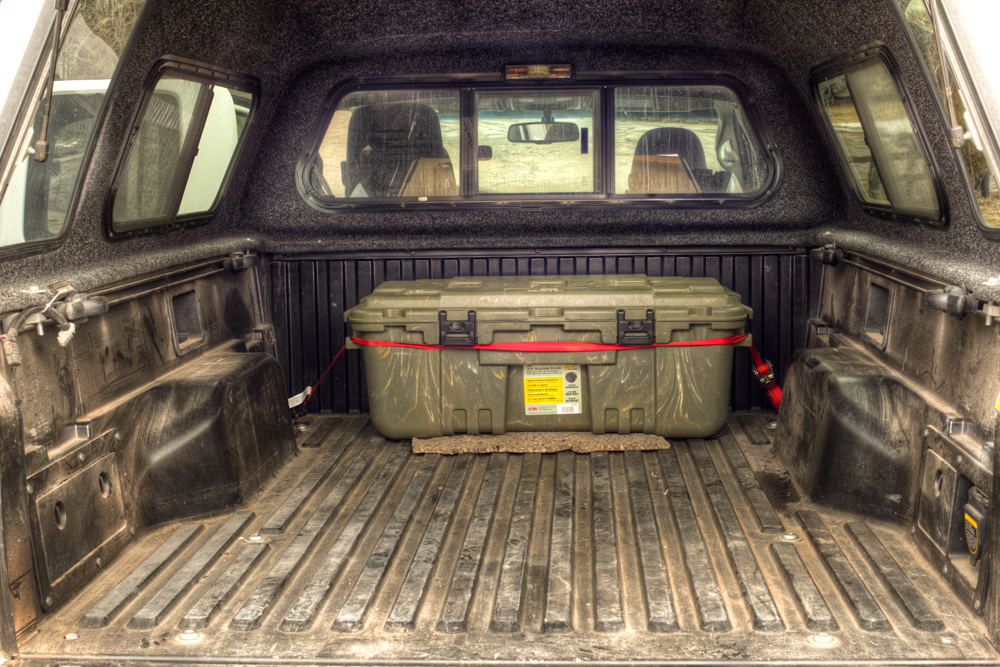
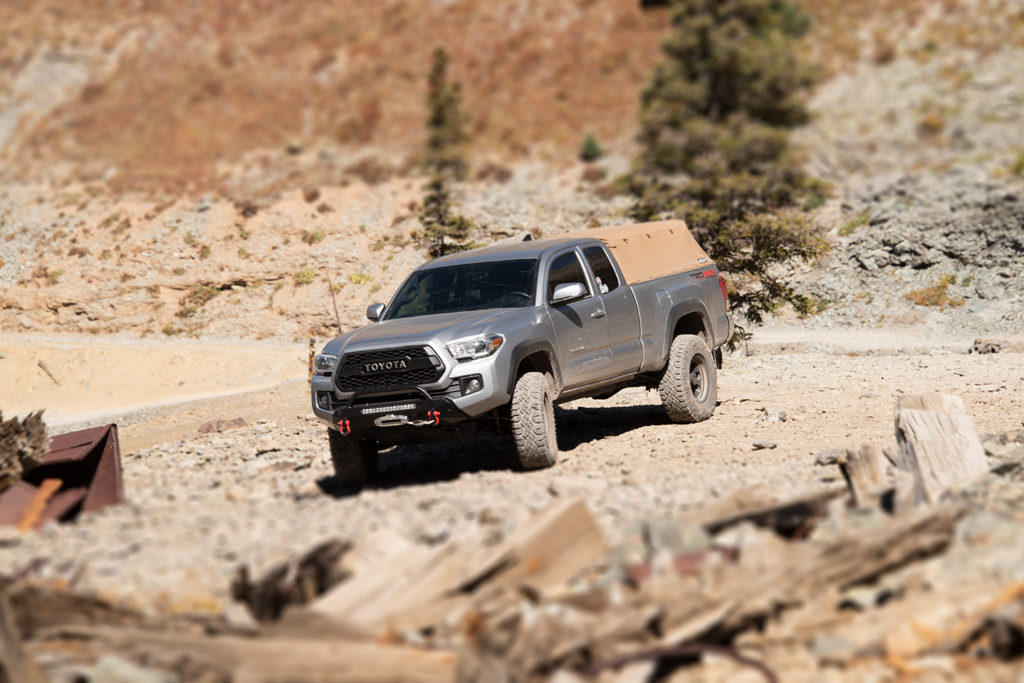
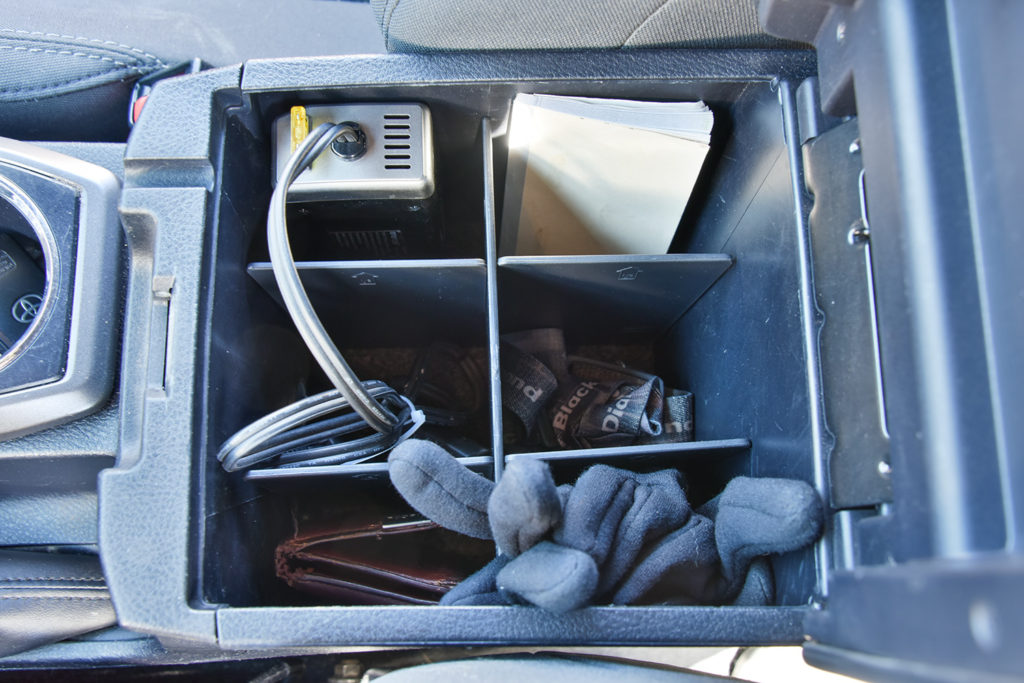
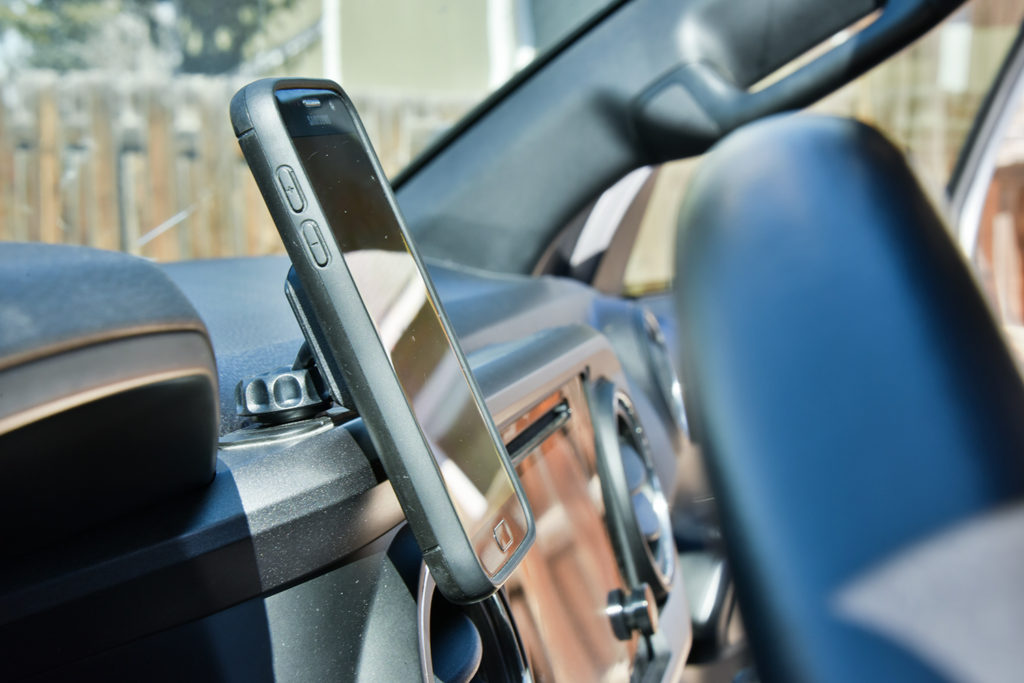
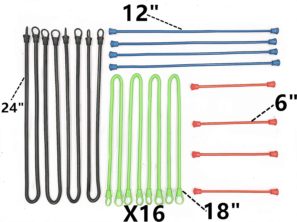 Access Cab Cargo Deck
Access Cab Cargo Deck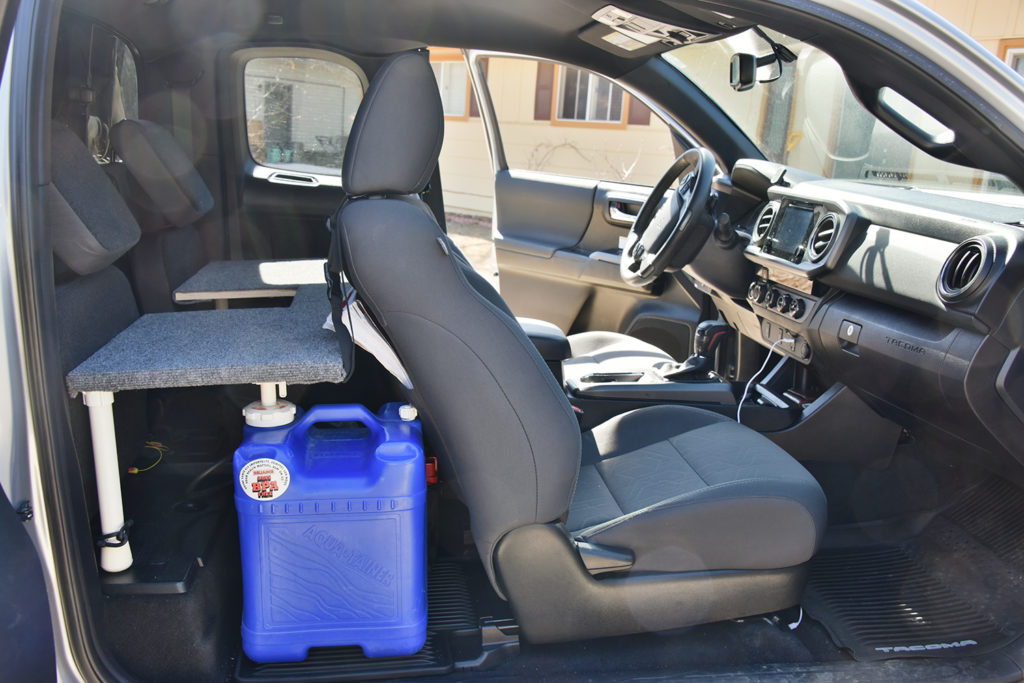
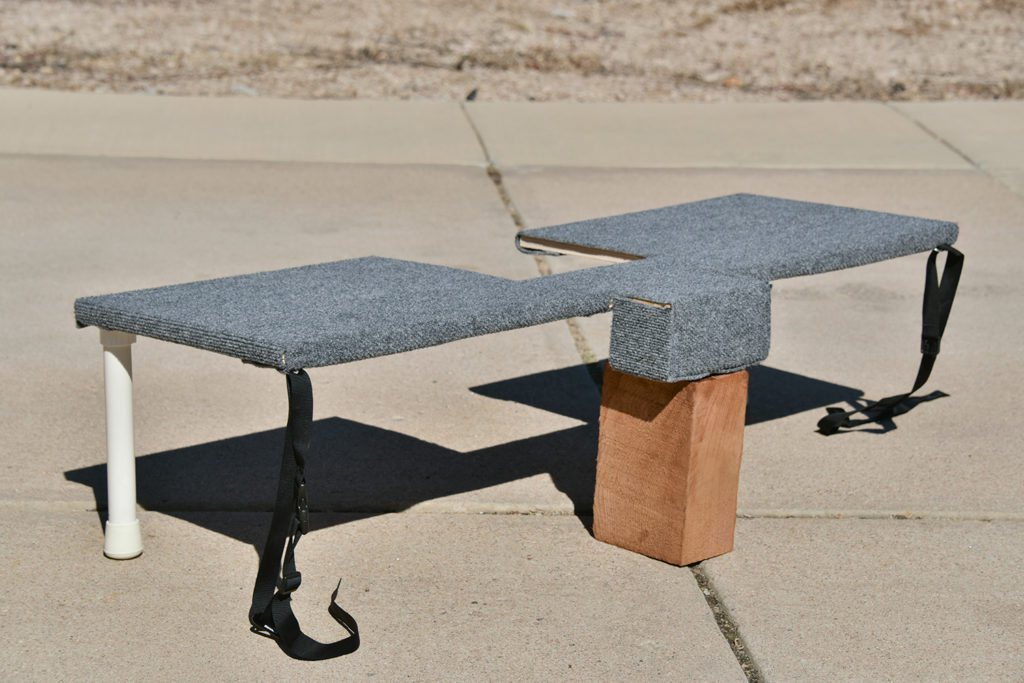

Bryan! I love your paired down set up! We’ve had our 2016 just over a year now, and much like with camera gear, i was starting to get GAS. I greatly reduced my camera gear a couple years ago and am wanting to take a measured, reasonable approach with the truck. No keeping up with the IG crew (like i was trying to) and just doing what works for our family. I appreciate you sharing your experience with the smaller tires and lift. Looking at OME 2″ all around in the future because with 2 car seats and all our gear, we’re overweight, but thinking I’ll stay with 32″ tires because who am i trying to impress? Thanks for the rechargeable jumpstarter tip (your link isn’t working) and the power strip in the bed for batteries! Do you do anything special for navigation? Had the Gaia app recommended but haven’t purchased a membership yet. Enjoy exploring and shooting! Thanks again!
Hi Mike, thanks for your feedback! For navigation I use a Garmin GPS that’s still going strong and I don’t have to worry about losing signal in remote areas. For hiking I use Gaia and pre-download maps before heading out.
Hi there Byran,
First of all your blog is amazing, and I hope to do a similar build to my Tacoma. I already built a similar sleeping deck based on your recommendations and I loved it! I have a question about swapping out the grill. Did you have any issues with the sensor? Did you do it yourself?
Thanks!
Hi Paul,
Thank you! I did the swap myself, but because it’s a 2017 I don’t have a sensor.
Hey Bryan, do you have any rubbing running a -12 mm wheel with 265 75r16? I have a 2016 double cab, exact color of yours. I am looking for this setup you have. Great looking truck Bryan!
I only have rubbing when I cut the wheel hard to it’s left/right limit when backing or parking
Hey Bryan,
Your truck looks awesome! And, like other people have mentioned, this is the most thorough and helpful build overview I’ve come across. Outstanding work.
I’m looking to do a similar lift with the same tire/wheel combo. Do you still have rubbing issues? If so, do you know where the rubbing is occurring? Maybe just on the mud flaps? The truck appears to have the front mud flaps in at least one of the photos, but does not have them in some of the other photos. Did you remove the front mud flaps? If so, did that solve the rubbing issues?
Thanks,
Sam
Hi Sam, Thank you, I do still have slight rubbing without the mudflaps. The tire rubs on the metal plate that’s located on the rear, inside of the wheel well. It only happens when I turn hard while reversing, and on rare occasion when I’m turning hard driving forward and my nose is dropping down on a rough trail. I rotate my tires like clockwork to keep this in check.
Mucho Thanks Brian for the very valuable answer regarding DCLB trail limits/scope, don’t have to find out the hard way now, can save money and all the extra weight. Newb here just wanting to get out there off the grid with a 10 yr old grandson. Surely not after mangled rocker panels or broken driveline bragging rights. Im after experiencing some of them stupendous scenes you are capturing! The truck is secondary.
No problem Bill, just some data to further help…wheeling the most challenging trails is purely for the thrill, however, none of my shots have actually come from driving any of them. It just so happens that of my shots that have come from Jeep trails, they’ve all been from the moderate routes or easy forest roads.
One of the most comprehensive lists of equipment I’ve come across. Thank you so much!
Thank you Steve!
Really like your simple, low weight, low CG, minimalist build!
How dry does the softopper stay in a windy rain storm?
Are you still able to access the cab thru the back window in the rain storm?
Thanks for finding the C rated tire! What is the lowest psi you have aired down the tires? (in snow?)
I have a 2018 OR DCLB and would like to be able to drive on the same mountain pass jeep trails you are. But with my lower break-over angle, will I need sliders and better skids? Will the trail turns be too tight for a longer truck?
Thank you so much for sharing all your valuable experiences/tips. Your write up is perfect for someone like me wanting to get into Overlanding without spending tons of money, daily drives their truck and needs to haul other stuff in the bed.
Thanks Bill! The Softopper stays bone dry in weather, but I also thoroughly dust-proofed any gaps and seam-sealed all of the stitches. The softopper doesn’t connect to the cab, but I can’t fit through the sliding back window anyway. I air down to 18 psi on gnar, have never aired down in snow because the Duratracs bite like mad without help. In my truck I often barely miss scraping my belly on the most difficult trails, but get still away with running no armor, though my wimpy stock skid plate is dented. So the question is whether to carry 500+ extra pounds of steel around everyday for the occasional difficult trail like Fins n Things in Moab, Black Bear, Schofield… or just stick to still highly adventurous trails rated 7 and below like Ophir Pass, Engineer Pass and countless others. In any case you won’t be able to make it around hairpin turns without backing up in your DCLB.
Bryan, I like the build. Will be doing the same. Specific to the lift, suspension, tires and wheels; are you satisfied with what you did? Is there anything you would change or do differently? Do you think the LT tires are a bit too firm for this size of truck? I plan on doing a hard top bed topper.
Hi Brian, I’m 100% satisfied with this build. My last truck is where I had things that I would change and this truck is the evolution. My OME suspension is very smooth and got rid of the body roll with the stock suspension and the Goodyear tires have a C load rating so aren’t too firm at all.
Do you have a manual or automatic? I like the engine braking going downhill with a manual.
It’s auto, but like most auto transmissions these days you can manually select the gear, which still works for downhill braking.
Thank you
Hi Bryan,
Just came across your page … Very, very nice write-up! Would love to see how you store and carry your photography related gear. Do you just bring a camera bag or do you have something specific for that as part of your setup? As an aside, my ’18 Taco set up is very similar (RTT instead of topper tho), so thrilled with the “validation”. Thanks.
I use camera bags to store my gear in lieu of a setup built into the truck. It works for me because I can just grab a prepacked bag and go. Behind the seats I built a storage deck that lets me store 2 rows of bags inside my cab.
Bryan great write up man, I gotta ask, Have you taken your Tacoma off any sweet jumps?
I used to all the time Ben, but that’s why i have to ride the bus to school now
What camera lenses do you use when shooting the Tacoma off road?
Pretty much all of them, but often my 50mm prime and 28-300mm
Hey Bryan, I agree with the others, Great job with the site, very informative, nice photos and a sweet truck. I actually live in Lyons, CO, near you, and I have a 2007 Tacoma I’m building and it’s almost identical to yours. I have a Wildernest topper though and love it. I’d love to pick your brain sometime about places you’ve gone and input on your truck.
Thanks,
Mike
Thanks Mike, those Wildernest toppers are sweet and so is living in Lyons! Feel free to let me know any questions you have.
Is there any chance you can email me photos of your topper seal set up or at least where you put the expandable foam ? Fighting mine on dust proofing
I added photos in the blog above as to where I put the adhesive seal tape and Truxedo tailgate liner. I can’t really get to the foam to photograph it because I used the applicator tube to apply it deep down into cracks between the topper and the bed. The most effective single step to sealing my bed was actually the Truxedo tailgate liner because there’s a huge crack between the tailgate and bed that needs to be sealed up. I have ZERO dust.
Bryan, very impressive build. This is a photographers dream! Getting that extra height is crucial for some shots. I have a build going as well and cant wait to get another 15 feet in the air. 2014 Trail Runner Super White. : )
Thanks Brenan, at first I couldn’t picture how you were getting 15′, but your building out an RV trailer!
Good afternoon Bryan! Love what you’ve done to your Taco! I just purchased a Snugtop Hi-Liner Sport for my 2010 taco and am going to build a raised bed similar to yours. I’ve been chewing on how I want to design it for a while and yours seems to be the closest to what I want. Do you find it all that useful to have the split bed? or do you tend to keep the full size bed in? I am thinking of building it so that there are no supports in the middle of the bed to make storage space underneath more usable. But I do kind of like the idea of being able to have a half bed as well. What are your thoughts on this?
Thanks in advance!
Travis
Hey Travis,
After having used this deck for a few years now, I can say I’m very happy to have it as a split design because I use both configurations regularly. The nice thing about the split configuration is that it serves as a bench so that you can put your feet down and maneuver inside the truck. Basically when I want things faster and easier I keep it split. When I have company, want to sprawl out, or just want to throw a bunch of blankets and pillows back there I use the full deck. The full deck is more comfortable, but you have to open the back of the truck to move around.
^Dire – you may a valid concern, but you should work on your delivery. Although your name fits your dire warning…
Bryan – awesome build! I’m new to over landing and want to build my Tacoma in a similar style, totally capable but simple. What kind of rear locker do you have? I’m assuming it’s not ARB because that requires an on board air compressor, which you said you avoided.
Hi Joe, thank you, my rear locker is stock Toyota that comes with the TRD package.
Sitting an unsecured Hi-Lift in your cabin is an excellent way to kill you and everyone riding with you, should a rollover or high-speed collision occur.
Your truck is pretty bad ass. I’m trying to build a platform similar to yours, I like the simplicity. I’m having a hard time seeing what supports the sides of yours. Any chance you can explain a bit more?
Thanks Becky. As you’ve probably seen, there’s a ledge built into the side of the bed on the Tacoma. A lot of people just rest their platforms directly on that and the wheel well, so there’s no side support needed. However, that setup is too short for me. The side supports I added are just short sections of 2×4, wrapped in carpet as to not damage the plastic bed. The three 2×4 supports on each side rest on the ledge and the wheel well. To get the right height, I screwed a 2×4 vertically to a flat 2×4. But if I were to do it over, I’d just stack three flat 2×4’s together. Hopefully you can now see in the pic what I’m describing.
Incredible website, very informative, one of the best I have seen for Colorado photo trips.
I really enjoyed your write up on the Tacoma, I have a 2005 I am wanting to make more comfortable for photo trips.
Got some great ideas from your blog. Thanks and keep up the great work!
Thanks Cody and good luck modifying your Taco!
Hi, Congrats on a great looking vehicle. I have a similar Tacoma and was curious if your gas mileage suffered by going to the taller, spaced out tires? Also, any issues with the Leer 122? I’m looking to order one soon.
Thanks, Ben
There’s been no NOTICEABLE change in MPG going with the taller tires. According to physics, you should get better mileage when going fast, and worse mileage when driving slow with a taller tire. As for spaced out, I made that change right when I got the truck and never made a comparison so I don’t know if it hurt my gas mileage. With all the mods and extra weight, I get about 20 MPG highway, where a stock taco can get up to 26. After 3 years I still like my Leer 122.
FWIW – I have those exact rims with stock tires & suspension. I did have rubbing at first, but Tacomas to have a castor adjustment. Between that adjustment and removing the mud flaps, I have no rubbing at all. Maybe worth noting … I had IVD long travel RR Shocks paired with their control arms. The rubbing I experienced was BOTH with and without the IVD. Selling that setup, BTW.